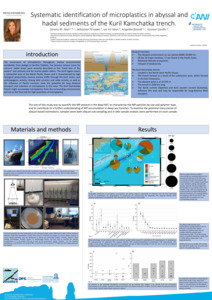Systematic identification of microplastics in abyssal and hadal sediments of the Kuril Kamchatka trench
Contact
serena.abel [ at ] awi.de
Abstract
The occurrence of microplastics throughout marine environments worldwide, from pelagic to benthic habitats, has become serious cause for concern. Hadal zones were recently described as the “trash bins of the oceans” and ultimate sink for marine plastic debris. The Kuril region covers a substantial area of the North Pacific Ocean and is characterised by high biological productivity, intense marine traffic through the Kuril straits, and anthropogenic activity. Strong tidal currents and eddy activity, as well as the influence of Pacific currents, have the potential for long distance transport and retention of microplastics in this area. The Kuril Kamchatka Trench might accumulate microplastics from the surrounding environments and act as the final sink for high quantities of microplastics.
Item Type
Conference
(Poster)
Authors
Divisions
Primary Division
Programs
Primary Topic
Publication Status
Published
Event Details
MICRO2020, INTERNATIONAL CONFERENCE 23-27 NOVEMBER; LANZAROTE FATE AND MICROPLASTIC : KNOWLEDGE AND RESPONSABILITIES, 23 Nov 2020 - 27 Nov 2020, Lanzarote.
Eprint ID
53863
Cite as
Abel, S.
,
Senckenberg Research Institute and Natural History Museum; Department of Marine Zoology, Senckenberganlage 25, 60325, Frankfurt am Main, Germany, Goethe University Frankfurt, Institute for Ecology, Diversity and Evolution, Max-von-Laue-Straße 13, 60438, Frankfurt am Main, Germany
(2020):
Systematic identification of microplastics in abyssal and hadal sediments of the Kuril Kamchatka trench
,
MICRO2020, INTERNATIONAL CONFERENCE 23-27 NOVEMBER; LANZAROTE FATE AND MICROPLASTIC : KNOWLEDGE AND RESPONSABILITIES,
Lanzarote,
23 November 2020 - 27 November 2020
.
Download
![[thumbnail of 337476_MICRO2020_poster.pdf]](https://epic.awi.de/53863/1.hassmallThumbnailVersion/337476_MICRO2020_poster.pdf)

Preview
Share
Geographical region
Research Platforms
Campaigns
N/A
Actions
 Edit Item
Edit Item



